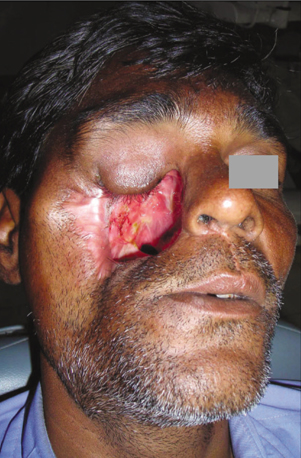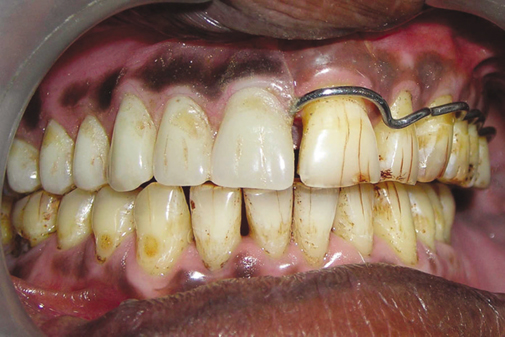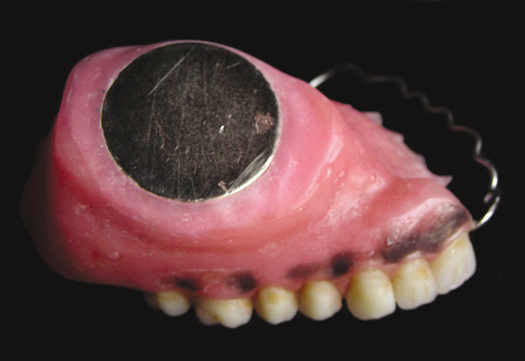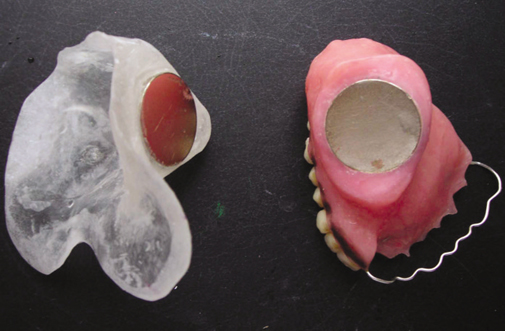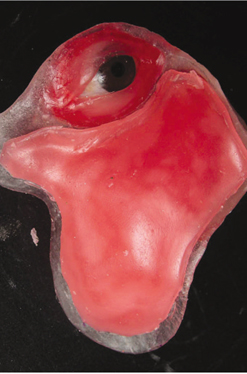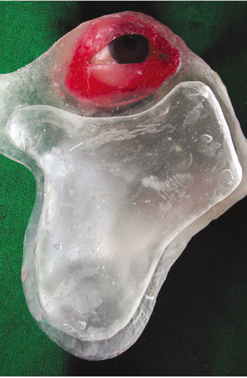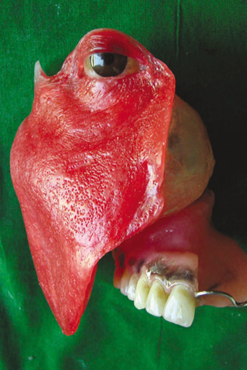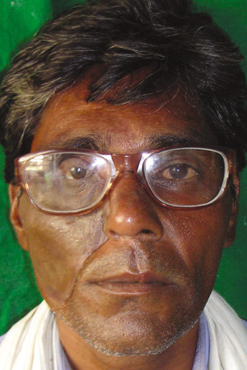J Adv Prosthodont.
2010 Sep;2(3):65-70. 10.4047/jap.2010.2.3.65.
Modified technique to fabricate a hollow light-weight facial prosthesis for lateral midfacial defect: a clinical report
- Affiliations
-
- 1Department of Prosthodontics, Government Dental College and Hospital, Nagpur, Maharashtra, India. pravinandsmita@yahoo.co.in
- KMID: 2118108
- DOI: http://doi.org/10.4047/jap.2010.2.3.65
Abstract
- Large oro-facial defects result from cancer treatment consequences in serious functional as well as cosmetic deformities. Acceptable cosmetic results usually can be obtained with a facial prosthesis. However, retention of a large facial prosthesis can be challenging because of its size and weight. This article describes prosthetic rehabilitation of a 57-year-old man having a right lateral mid-facial defect with intraoral-extraoral combination prosthesis. A modified technique to fabricate a hollow substructure in heat-polymerizing polymethyl-methacrylate to support silicone facial prosthesis was illustrated. The resultant facial prosthesis was structurally durable and light in weight facilitating the retention with magnets satisfactorily. This technique is advantageous as there is no need to fabricate the whole prosthesis again in case of damage of the silicone layer because the outer silicone layer can be removed and re-packed on the substructure if the gypsum-mold is preserved.
Keyword
MeSH Terms
Figure
Reference
-
1. Marunick MT, Harrison R, Beumer J 3rd. Prosthodontic rehabilitation of midfacial defects. J Prosthet Dent. 1985. 54:553–560.2. Guttal SS, Patil NP, Shetye AD. Prosthetic rehabilitation of a midfacial defect resulting from lethal midline granuloma-a clinical report. J Oral Rehabil. 2006. 33:863–867.3. Kurunmäki H, Kantola R, Hatamleh MM, Watts DC, Vallittu PK. A fiber-reinforced composite prosthesis restoring a lateral midfacial defect: a clinical report. J Prosthet Dent. 2008. 100:348–352.4. Thomas KF. The art of clinical anaplastology. Techniques and materials guide for successful facial and somato prosthetic rehabilitation. 2006. 2nd Ed. London: S Thomas;16–22.5. The glossary of prosthodontic terms. J Prosthet Dent. 2005. 94:10–92.6. Schaff NG. Winkler S, editor. Maxillofacial prosthetics. Essentials of complete denture prosthodontics. 1994. St. Louis: Ishiyaku EuroAmerica;403–415.7. Hecker DM, Wiens JP, Cowper TR, Eckert SE, Gitto CA, Jacob RF, Mahanna GK, Turner GE, Potts A, Logan H, Wiens RL. Can we assess quality of life in patients with head and neck cancer? A preliminary report from the American Academy of Maxillofacial Prosthetics. J Prosthet Dent. 2002. 88:344–351.8. Brignoni R, Dominici JT. An intraoral-extraoral combination prosthesis using an intermediate framework and magnets: a clinical report. J Prosthet Dent. 2001. 85:7–11.9. Morrow RM, Rudd KD, Rhoads JE. Dental laboratory procedures complete dentures. 1986. 2nd ed. St. Louis: Mosby;312–338.10. Lemon JC, Martin JW, King GE. Modified technique for preparing a polyurethane lining for facial prostheses. J Prosthet Dent. 1992. 67:228–229.11. Udagama A. Urethane-lined silicone facial prostheses. J Prosthet Dent. 1987. 58:351–354.12. Thomas K. Prosthetic rehabilitation. 1994. London: Quintessence Publishing;93–103.13. Beumer J III, Curtis TA, Marunick MT. Maxillofacial rehabilitation: prosthodontic and surgical considerations. 1996. St Louis: Ishiyaku EuroAmerica Inc;408–416.14. Dumbrigue HB, Fyler A. Minimizing prosthesis movement in a midfacial defect: a clinical report. J Prosthet Dent. 1997. 78:341–345.15. Verdonck HW, Peters R, Vish LL. Retention and stability problems in a patient with a large combined intra- and extraoral defect: a case report. J Facial Somato Prosthet. 1998. 4:123–127.16. Menneking H, Klein M, Hell B, Bier J. Prosthetic restoration of nasal defects: Indications for two different osseointegrated implant systems. J Facial Somato Prosthet. 1998. 4:29–33.17. Worthington P, Brånemark PI. Advanced osseointegration surgery: Applications in the maxillofacial region. 1992. Carol Stream, Ill: Quintessence;307–326.18. Arcuri MR, LaVelle WE, Fyler E, Jons R. Prosthetic complications of extraoral implants. J Prosthet Dent. 1993. 69:289–292.19. Roumanas E, Nishimura R, Beumer J III, Moy P, Weinlander M, Lorant J. Craniofacial defects and osseointegrated implants: Six-year follow-up report on the success rates of craniofacial implants at UCLA. Int J Oral Maxillofac implants. 1994. 9:579–585.20. Taft RM, Cameron SM, Knudson RC, Runyan DA. The effect of primers and surface characteristics on the adhesion-in-peel force of silicone elastomers bonded to resin materials. J Prosthet Dent. 1996. 76:515–518.
- Full Text Links
- Actions
-
Cited
- CITED
-
- Close
- Share
- Similar articles
-
- Magnet retained intraoral-extra oral combination prosthesis: a case report
- A hollow definitive obturator fabrication technique for management of partial maxillectomy
- Maxillofacial rehabilitation of hemi-maxillectomy patient using a closed hollow bulb obturator fabricated by one-step polymerization technique: a clinical report
- Prosthetic rehabilitation for a maxillectomy patient using 3D printing assisted closed hollow bulb obturator: a case report
- A simple technique to fabricate a surgical obturator restoring the defect in original anatomical form

